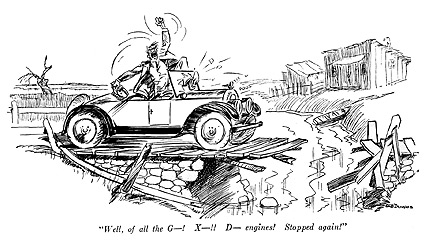from Judge
What Happens When a Chicken Crosses the Road?
by Ellis Parker Butler
For a long while, almost since Noah docked his ship, people have been seeing chickens cross the road, but they have not given the phenomena the attention they should. This is because people know hardly anything about modern science. To them a chicken crossing the road is merely a chicken crossing the road. They say, "Ah! There is a chicken crossing the road; where shall we stop for lunch." That is the common attitude of the lay mind, but we scientists know how wonderful are the operations that take place when even an ordinary chicken crosses the simplest sort of road.
Let us suppose the chicken is a female chicken of some fourteen months of age, with feathers on its outer side. We see the chicken at one side of the road as our automobile approaches. The chicken then starts across the road. We observe that it stretches out its neck, lifts its right leg and then its left leg, and our wife then says, "Oh! George! You have run over that chicken."
We will now have to select another chicken for our experiment because that one is not good for much any longer. We now select a speckled chicken of the female sex, aged fifteen months. It is, let us say, at one side of the road, which we will call "A." The chicken desires to reach the other side of the road, which we will call "B." For fifteen months the chicken, which we will hereafter call the party of the first part, has had no desire to reach the other side of the road because there is nothing there to tempt its appetite or, as we scientists term it, appetite. A large touring car now approaches from the east, $800 having been paid down and the balance in twelve notes, one due each month. If we look closely we will see that the car has shock absorbers. These cost a little extra, but are worth the money as the shock comes regularly each month when the notes fall due.
When we see the chicken at the side of the road, which we will call "C," we say, "There is a chicken that will remain at that side of the road, which we will call 'D,' for a great many years." But we do not know chickens or we wouldn't say that. Immediately upon hearing the automobile approaching it, the chicken says to itself, "I must get to the other side of the road, which I will call 'E,' immediately." This is because the noise of the automobile, reaching the chicken in waves, penetrates the eardrum (X) and passing through the esophagus (ff) expands the gizzard (J), thus causing the appetite (M) to hunger for a bite of the old shoe (s) on the opposite side of the road (Q). The chicken then lifts its leg (v) and stretches out its neck (Fig. 6) at the same time flapping its wings (k and kk) and starts across the road (*).

Now suppose that, instead of stopping at the Pockatock Inn for lunch, we magnify the brain of that chick two million times. The brain of the chicken is now as large as a mosquito's eye. What do we see? Nothing. But suppose we multiply the chicken's brain twenty million times. We find now that the brain of the chicken is composed of cells. Each cell contains a pitcher of water, a loaf of bread, a small iron cot and a washbasin bolted to the wall in the corner. The bars at the window are of chilled steel half an inch in diameter. We will take one of these cells, already multiplied twenty million times and multiply it fourteen million times more. If we are cell experts we now see that these cells are quite different from those at, let us say. Sing Sing or Auburn. The cells at Sing Sing and Auburn are bolted on the outside so that nothing can get out of them; the cells in a chicken's brain are bolted on the inside so that nothing can get into them!
We look into the cell awhile and the Mrs. remarks that it don't look like much to her, if anybody should ask her, and that if we don't start soon we will not get to the Pockatock Hotel in time for dinner because the dining-room closes at eight. Or anyway it did the last time we went there, because you remember we had the blowout at that place where the chicken crossed the road.
This brings us back to the chicken crossing the road once more, but we have on our hands a chicken brain multiplied two million times twenty million times, with the cells magnified fourteen million times that. The question is what we shall do with these things. Some of the party are in favor of leaving them where they are, but some think we ought to rake them up in a pile at the side of the road and burn them, so we throw them over the wall into the meadow and drive on.
Now let us see what we have learned. We drive six miles further to the crossroads and find we should have taken the left turn at the crossroads one mile before we came to the chicken.
These are the things that make modern science so thrilling to those who approach it in the proper spirit. Or even in a Ford.